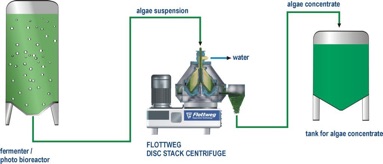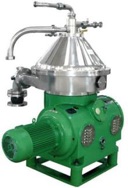1. Microalgae and its metabolites
1.5 Biomass, bioproducts and biomolecules from microalgae.
Microalgal biomass is a product on its own. It is a food used since ancient times in certain places of the world and it is also an important product in aquaculture.
Microalgal biomass is also a source of complex biomolecules tah can appear in extracts (lipid extract) or as isolated biomolecules (asthaxantin). Thus, we may produce.
Generic products:
Biomass: As culture broth or “green waters”, paste, frozen or dehydrated biomass (spray-dried oz freeze-dried being very usual drying methods).
Bioproducts: Result of processing the biomass. Biodiesel or biofertilizers are bioproducts. Pigment extracts are also bioproducts.
Biomolecules: Are single, isolated biomolecules, such as EPA, Lutein od phycocyanin.
The main constituents of microalgae can be classifierd into three large groups or classes of similar compounds: protein, lipids (of which fats are the larger part) and carbohydrates. There are some other important classes such as nucleotides.
The table shown below can give us an idea about what we can find in microalgae and also allows to evaluate the variability found among different species.


Questions and exercises.
-
• Find out how is microagal biomass consumed in aquaculture (paste, suspension, culture, ...). Try to find a commercial brand.


Filtration.
Filtration separates particles from a liquid by means of a filtering medium with an adequate pore size that retains microalgae and lets water and dissolved salts pass through.
Microalgae are in general difficult to filter because they are small and clog the filtering medium rapidly. Additionally, some components usually excreted to the medium by the microalgae, such as exopolisaccharides, tend to increase the viscosity of the liquid, hampering the separation.
Below, you can see a belt filter being scrapped to gather the microalgal biomass as paste. Belt filters are particularly suited for microalgae al the layer deposited on the filtering medium is thin and continuously removed, so that clogging can be kept at bay.


The problem of microalgal technology is to find out how to separate those components efficiently. We will discuss some alternatives in class.
In any case before we can process teh biomass, we need to separate it from the culture broth. This is called “harvesting”.
HARVESTING
As an analogy with other crops, “harvesting” is the name given to the process of recovering the biomass from the culture broth.
Biomass can be separated by difference of density. Since the difference of density is not big, sometimes a separation operating is required, such as filtering, centrifuging or decanting but that last only work with some microalgae or if a flocculant is added to promote the formation of flocks.
In the pictures below, you can see a microalgae decanting after an induced flocculation.


To calculate the size of the settler needed for a decantation, either natural or induced by a flocculant, we need experimental data from an experiment as the one shown below. The you can use a method such as Kinch-Roberts or Coe-Clevenger.
That is just for the settler. To know what is the best flocculant and the dose, we need additional experimentation:

The figure on the right shows a typical experimentation carried out to find an adequate flocculant and the appropriate dose.


Centrifugation.
Decantation is intrinsically slow and biomass can decay ant rot. When a faster separation is needed, a centrifuge can be used instead.
Centrifuges are much faster, the concentration factor is higher and the temperature can be controlled.
On the other hand, centrifugation is much more expensive than decantation and is mostly suitable for high value products.
Sizing a centrifuge is a matter of finding the area of the equivalent settler. This is calls “the sigma” of the centrifuge and is represented by the symbol ∑
We will non go in more detail as this is beyond the scope of this subject.
And that is enough about harvesting. Let’s see what are some processing options.
Below are the main components that can be found in microalgal biomass and ints chemical structure.






